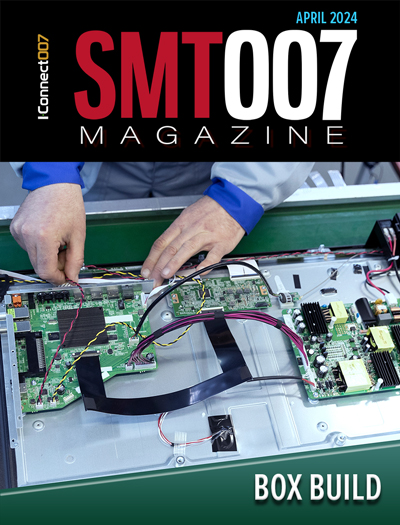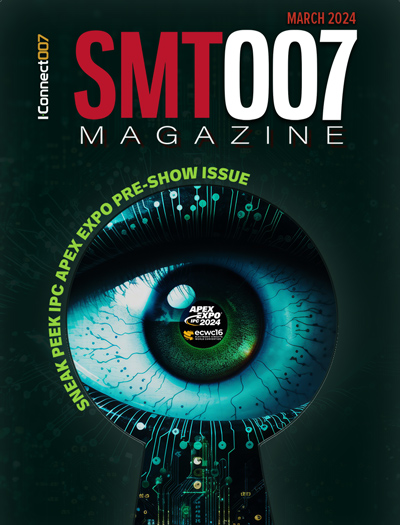-

- News
- Books
Featured Books
- smt007 Magazine
Latest Issues
Current Issue
Box Build
One trend is to add box build and final assembly to your product offering. In this issue, we explore the opportunities and risks of adding system assembly to your service portfolio.

IPC APEX EXPO 2024 Pre-show
This month’s issue devotes its pages to a comprehensive preview of the IPC APEX EXPO 2024 event. Whether your role is technical or business, if you're new-to-the-industry or seasoned veteran, you'll find value throughout this program.

Boost Your Sales
Every part of your business can be evaluated as a process, including your sales funnel. Optimizing your selling process requires a coordinated effort between marketing and sales. In this issue, industry experts in marketing and sales offer their best advice on how to boost your sales efforts.
- Articles
- Columns
Search Console
- Links
- Events
||| MENU - smt007 Magazine
Excerpt: The Printed Circuit Assembler’s Guide to… Smart Data, Chapter 2
April 21, 2021 | Sagi Reuven and Zac Elliott, Siemens Digital Industries SoftwareEstimated reading time: 1 minute
The following excerpt is from The Printed Circuit Assembler's Guide to...™ Smart Data: Using Data to Improve Manufacturing book.
Chapter 2: The Difference Between Data and Analytics
Companies have been collecting data in large volumes. Highly varied data from manufacturing operations comes in quickly that needs to be validated, and its value prioritized so that it can be turned into something useful—transformed from big data to smart data. The amount of data available has grown exponentially into big data. Twenty years ago, a PCB work order resulted in 100 data records, megabytes of data; today, it is 10 billion records, terabytes of data. The investment in collecting this data and storing it is high. However, without a way to analyze the data, without analytics, it will not result in ROI.
Using analytics provides the best results with high-quality data. However, with bad or non-validated, and inappropriately prioritized data, the most advanced analytics still can be misleading and a waste of time. What is high-quality data? It is data that has been normalized, formatted, and validated so that it can be translated and read to provide insights and foresight. It is data that can be understood at the point of consumption and be immediately acted on.
Data analytics is the process of examining data sets to draw conclusions about the information they contain. Manufacturing intelligence means taking big data, applying advanced analytics, and putting it back into manufacturing processes.
Analytics for manufacturing can be used in:
• Asset management for accurate, real-time utilization, and OEE
• Traceability for capturing and investigating complete material and process traceability data for individual PCBs, as well as full system assemblies, using high-availability big-data storage
• Operation and labor management to measure and analyze how resources are spent and track WIP in real-time
• Quality control to identify and analyze process and material failures and drive continuous improvement
• Design-to-manufacturing flow to detect factors affecting yield and point out areas for improvement
To download this free eBook, published by I-Connect007, click here.
To view the entire I-Connect007 eBook library, click here.
Other related content
I-007e Micro Webinar: Implementing "Digital Twin" Best Practices From Design Through Manufacturing
Realtime with I-Connect007 Roundtable: Siemens and Computrol: Achieving Operational Excellence in Electronics Manufacturing
I-Connect007 Column: Lean Digital Thread, from Sagi Reuven, Siemens Digital Industries Software
Suggested Items
TTM Celebrates the Grand Opening of Its First Manufacturing Facility in Penang
04/25/2024 | TTM Technologies, Inc.TTM Technologies, Inc., a leading global manufacturer of technology solutions including mission systems, radio frequency (RF) components and RF microwave/microelectronic assemblies, and quick-turn and technologically advanced printed circuit boards (PCBs), officially opened its first manufacturing plant in Penang, Malaysia with an investment of USD200 million (approximately RM958 million).
Elevating PCB Design Engineering With IPC Programs
04/24/2024 | Cory Blaylock, IPCIn a monumental stride for the electronics manufacturing industry, IPC has successfully championed the recognition of the PCB Design Engineer as an official occupation by the U.S. Department of Labor (DOL). This pivotal achievement not only underscores the critical role of PCB design engineers within the technology landscape, but also marks the beginning of a transformative journey toward nurturing a robust, skilled workforce ready to propel our industry into the future.
Fujitsu, METRON Collaborate to Drive ESG Success
04/24/2024 | JCN NewswireFujitsu Limited and METRON SAS, a French cleantech company specializing in energy management solutions for industrial decarbonization, today announced a strategic initiative to contribute to the realization of carbon neutrality in the manufacturing industry.
Real Time with... IPC APEX EXPO 2024: Final Finishes and IC Substrate Manufacturing
04/24/2024 | Real Time with...IPC APEX EXPOEditor Marcy LaRont and Richard DePoto, Uyemura's Business Development Manager, engage in a comprehensive discussion about the positive aspects of the show, the benefits of RAIG in final finishes, and the hurdles faced when upgrading your surface finish. Also discussed are the role of Uyemura's MEC pretreatment agents in IC substrate manufacturing and the importance of collaboration and knowledge sharing.
Women MAKE Awards Recognizes GlobalFoundries’ Jennifer Robbins and Katelyn Harrison for Manufacturing Excellence
04/24/2024 | GlobalFoundriesThe Manufacturing Institute (MI)—the workforce development and education affiliate of the National Association of Manufacturers—honored two outstanding women from GlobalFoundries (GF) at their annual Women MAKE Awards. Jennifer (Jenny) Robbins, Senior Director, Central Facilities, was recognized as a 2024 Women MAKE Awards Honoree, while Katelyn Harrison, Senior Integration Engineer, was honored as an Emerging Leader.


